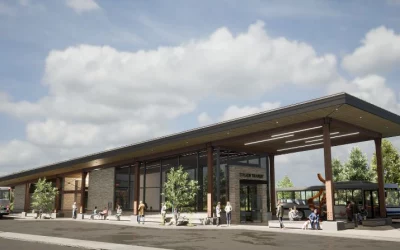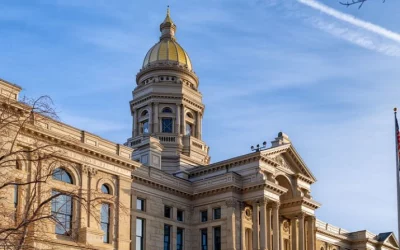Housing in the spotlight for local elections
The Teton County Democratic Party put housing in the spotlight as election season continues to heat up by hosting an affordable housing block party at the Center for the Arts on Sunday, June 4. The event highlighted resources for individuals trying to find affordable lodging in Jackson Hole.
State Rep. Mike Yin (D-Jackson), who is seeking reelection, spoke during the event about what he’s planning to do in Cheyenne in the near future to try and get more funding for local workforce housing programs. His efforts include “bringing back the real estate transfer tax bill that was brought last year.”
Yin also said other communities in Wyoming have seen housing costs rise since the pandemic began, and that multiple committees in the state legislature are looking into ways to solve the issue. That could mean warming up to ideas that Teton County delegates have been proposing for years.
Multiple candidates for local offices from across the political spectrum have identified housing as the number one issue they’re hoping to address should voters elect them this fall.
Wyoming Department of Education to hold talks on school safety
The Wyoming Department of Education announced Tuesday that it plans to host a series of roundtable discussions this summer with district superintendents from across the state to talk about school safety. The move comes after the recent shooting at Robb Elementary School in Uvalde, Texas, that killed 19 students and two teachers.
Communications director for the department Linda Finnerty said the meetings will be a chance for the state to hear how they can better support local districts–and for superintendents to learn from each other.
“Each part of the state has different challenges. We have older buildings, we have newer buildings. We have large and we have small,” Finnerty said, “so, bringing them together and sort of that shoulder-to-shoulder, we’re all taking it on [attitude]… can in and of itself be a helpful process.”
In a statement provided to KHOL this week, Executive Director of Communications and District Services for the Teton County School District Charlotte Reynolds said the district isn’t necessarily changing its security policies after Uvalde but that it regularly reviews protocols to ensure all students, employees and visitors are safe while at school. She also said the district is engaged in a number of efforts to support the mental health of local students. The Teton County school board was set to meet in executive session Wednesday night to reevaluate school safety, according to the Jackson Hole News&Guide.
Meanwhile, Jackson Hole High School students organized both a school walkout and evening demonstration at the Jackson Town Square to protest gun violence on Monday.
New conservation efforts for Western big game
The U.S. Department of Agriculture will partner with the State of Wyoming to conserve big game populations, the agency announced last month. Enhanced and newly-created incentive programs for private working landowners aim to promote voluntary preservation efforts for major American species, and the USDA hopes to scale up such efforts throughout the West.
Speaking during Yellowstone National Park’s recent 150th Anniversary Symposium in Cody, Undersecretary for Farm Production and Conservation Programs Robert Bonnie said that collaboration among local stakeholders in wilderness areas should help the Biden administration reach its ambitious conservation goals.
“In order to conserve functional ecosystems across boundaries, we have to work with—not against—states, tribes, private landowners [and] with, not against, agriculture, forestry,” Bonnie said. “A model which casts the federal government as dictator and solely as a regulator won’t work.”
The USDA said it will specifically target ranchers, farmers and forest landowners for the new funding opportunities, which will go towards protecting working agricultural land, creating new protections for wildlife corridors, and enhancing and restoring habitat. The initial price tag for the programs is $15 million. Stakeholder listening sessions are expected to take place over the coming months as the government finds out how best to spend the money.
Sen. Lummis introduces bill to regulate cryptocurrencies
Wyoming’s junior senator, Cynthia Lummis, introduced a bipartisan bill Tuesday that would regulate cryptocurrencies and other digital assets. Speaking in a Twitter forum, the Republican said the Responsible Financial Innovation Act would continue to allow for evolution in the growing digital asset world while creating some “rules of the road.”
“It’s been called, as you know, the wild, wild west. It’s an untamed territory where no one knows what the regulatory environment is going to look like,” Lummis said. “We want to provide some structure to the regulatory framework.”
The bill is co-sponsored by Democratic Sen. Kirsten Gillibrand of New York, but it’s unclear whether or not it will clear Congress before the midterm elections. Lummis herself is invested in Bitcoin and is a vocal advocate for cryptocurrency development. The bill’s introduction comes amid turmoil in the crypto world, including several high profile failures and meltdowns.
Advocates intensify calls to close Wyoming’s elk feedgrounds
As the Wyoming Game and Fish Department enters the third phase of its elk feedground management plan, conservation groups are calling on the state to prioritize the health of the Greater Yellowstone region’s wild herds and to begin shutting down 22 state-run feedgrounds in northwestern Wyoming, where tens of thousands of elk are artificially fed each winter.
Kristin Combs with Wyoming Wildlife Advocates said the move is essential for mitigating the spread of Chronic Wasting Disease. “We know that chronic wasting disease is definitely going to have a significant impact on the herd health,” Combs said. “The feedgrounds just set up this perfect recipe for basically a petri dish for the proliferation of disease.”
Comprehensive recommendations delivered this week by Combs’ group and five others call for the agency to phase out all state-run feedgrounds no later than 2028. The biggest challenge to phaseouts has come from the state’s livestock industry, which has long argued that feeding elk keeps them away from cattle and grazing areas.
This story comes from Eric Galatas of the Wyoming News Service.
Learn more about the challenge of shutting down elk feedgrounds in KHOL’s 2022 Regional Edward R. Murrow-winning story, “Feedground Managers and Wildlife Officials Aim to Curb CWD Spread Among Wyoming Elk.”
Climate change accelerating aridification in Colorado River basin
A new study found that the upper Colorado River basin is drying out due to climate change. As a result, parts of Colorado, Utah and Wyoming could more closely resemble the desert Southwest in the future.
Research from the Los Alamos National Laboratory predicts that mountain snow will start melting and running into streams and reservoirs much earlier. Scientists used artificial intelligence to test out different climate models over the next 30 years. Although there was some uncertainty, those models generally pointed towards loss of high-altitude snowpack due to warmer temperatures.
Mountain snow is the largest source of water for the Colorado River, which supplies about 40 million people throughout the region. The changes are part of a process called aridification—a long-term drying that means conditions previously considered to be drought are instead the new normal.
The study predicts more arid conditions in the Green River Valley near the border of Colorado, Utah and Wyoming. A wet spring has given the Cowboy State some good news in the short-term, however: All of western Wyoming’s watersheds have above-average snowpack for this time of year, according to the Natural Resource Conservation service.
Alex Hager of KUNC in Greeley, Colorado, contributed to this story.






